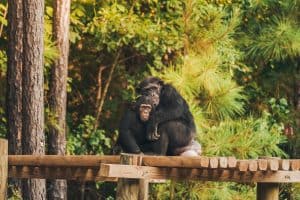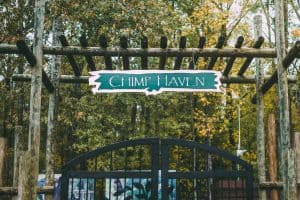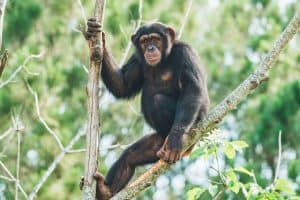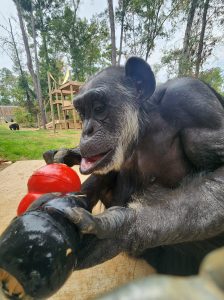
Chimp Haven: A second chance at forever
As the world’s largest chimpanzee sanctuary, Chimp Haven is home to more than 300 chimps who were formerly used in biomedical research. Now, at the 200–acre forested sanctuary in Louisiana, the chimps have the opportunity to just be chimps and enjoy many of the experiences they would have in the wild.
Each chimp comes to Chimp Haven with their own unique background and story. This remarkable sanctuary hosts a diverse community of chimps of all ages and backgrounds, provides them with a safe and enriching environment. It is here where they get a new start on life. 
Live, learn, love.
Chimpanzees are humans’ closest cousins; they want to learn, socialize, and play. So, when a new chimp or group of chimps arrive at Chimp Haven, they are given the opportunity to live in large, dynamic social groups and a variety of living spaces that provide ample opportunities for new and enriching experiences.
Upon arriving at the sanctuary, they have a brief stay at Chimp Haven’s Welcome Center, a quarantine area to help them acclimatize to their new surroundings and ensure they have a clean bill of health before meeting new friends. Since every chimp’s background and personality is different, the quarantine period also allows Chimp Haven staff to get to know the chimps, ensuring they can find the perfect family match for them.
Every chimp at Chimp Haven becomes part of a larger social group, which helps ensure their social needs are met. Chimps are highly social animals, thriving in groups that create a family atmosphere, like in their natural habitat. Social groups at Chimp Haven include up to 20 members, allowing for a rich and dynamic social environment.
One of the most fascinating aspects of chimp behavior is their lifelong ability to learn. Like humans, they are curious and observant, constantly learning from their surroundings and each other. By placing them in socially diverse groups, they can learn new behaviors, tasks, and even culinary preferences from others. This social learning dynamic mirrors the social dynamics found in the wild. 
You might wonder why these chimpanzees aren’t returned to their wild habitat. Despite their adaptability and intelligence, releasing chimps into the wild would pose significant challenges. Nearly all the chimps at Chimp Haven have been raised under human care for their entire lives, and thus they lack the vital survival skills necessary for thriving in the wild. Further, the environments they would be released into may not be suitable or safe due to habitat loss and human encroachment. Chimp Haven serves as a vital sanctuary where these chimps can live out their days in comfort and security.
Chimps each have unique personalities—from playful and curious to affectionate and clever. While each is unique, many display a sweet disposition toward familiar group members and caregivers, showcasing their emotional intelligence and capacity for forming bonds. This helps us understand their family dynamics better, as well as how they learn to survive.
As they age, chimps undergo changes in both physical appearance and behavior. While their playful antics may somewhat diminish, their capacity for learning and exploration remains strong. Chimpanzees continue to engage in various forms of play and enrichment throughout their lives, even as their preferences evolve.
KONGs for Chimps (and other fun enrichment!)
Chimp Haven provides various daily activities and stimuli to keep their residents engaged and fulfilled. From food puzzles to sensory time, each day brings new opportunities for exploration and engagement. Enrichment not only occupies their time, but it also stimulates their cognitive and physical abilities, fostering a rich and fulfilling environment.
The chimpanzees at Chimp Haven experience a variety of food and non-food enrichment, challenging their cognitive skills and encouraging younger or newer chimps to learn from others. Novel foods like coconuts, pumpkins, and pomegranates are given to pique curiosity and challenge their skills. Daily food enrichment might also include scattering food for foraging practice, puzzle toys like KONGs (Yes! Just like the one your dog uses for enrichment), or “fishers,” food stuffed in tight spaces that the chimps can “fish” for. 
Much like dogs, chimps gain enrichment and stimulation from the challenge and reward a stuffed rubber KONG toy provides.
Non-food items include destructible items and sensory outlets. Destructible items like streamers, magazines, cloth material, and toys are provided to the chimps to use as tools or to create nests, and some chimps even like to look at the magazines! Sensory items like music, a movie projector, bubbles, and new smells provide other forms of novelty and entertainment in their environment.
How you can help
Chimp Haven relies on the generosity of supporters to provide the chimps with a wonderful retirement in sanctuary. Whether through donations, volunteering, or spreading awareness by simply sharing a social media post, every contribution makes a difference. By understanding and appreciating the complexities of chimp behavior and the importance of sanctuary environments like Chimp Haven, we can work toward a better future for our closest relatives in the animal kingdom.
Visit www.chimphaven.org for more information. Click on the “Ways to Help” tab for a full list of opportunities.
Follow and share Chimp Haven on social media:
Facebook: www.facebook.com/ChimpHaven/
Instagram: www.instagram.com/chimphaven/
 from KONG & Chimp Haven
from KONG & Chimp Haven



